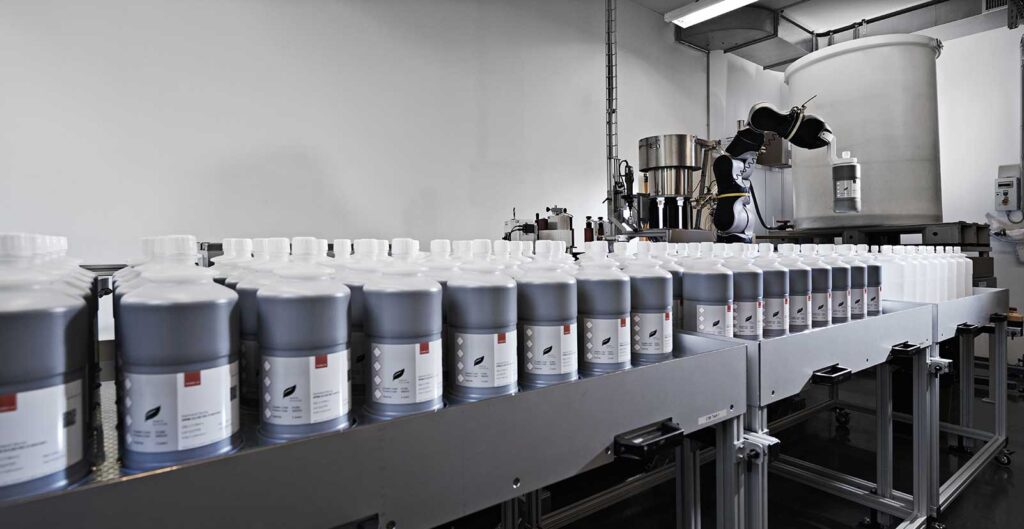Solutions
Precision Lapping
Achieving Ultra-Smooth and Accurate Surface Finishes
Lapping is an essential process in precision surface finishing, widely used to achieve ultra-smooth, flat, and precisely prepared surfaces on a variety of materials. At Pureon, we understand that lapping is more than just a step in the production process; it is a delicate art that requires the right equipment, materials, and expertise to deliver outstanding results. Here, we provide insights into the components and factors that define successful lapping processes.
What is Lapping?
Lapping is a specialized finishing process that involves abrading surfaces with fine, abrasive particles suspended in a liquid to achieve extreme flatness, smoothness, and dimensional accuracy. Unlike grinding, lapping is a gentle, low-pressure process used to remove awell-defined amount of material, ensuring surfaces are even and free from imperfections. This process is widely applied in industries that demand high precision, such as optics, semiconductors, and engineering components.

Important Components for a High-Quality Lapping Process
A successful lapping process relies on several essential components, each playing a crucial role in achieving the desired surface finish, flatness, and tolerance levels. Understanding the roles and characteristics of these elements enables precise control over material removal and ensures uniformity across the workpiece. These components work in harmony, and an in-depth understanding of their interactions allows for fine-tuning the process to meet exacting specifications. Mastering these key elements is essential for optimizing the lapping process and achieving ultra-smooth, accurate surface finishes. The following components impact the success of your lapping operations:
Lapping Slurry: The slurry’s abrasive particles directly affect the finish quality and material removal rate
Lapping Plate: The plate material, flatness, and conditioning determine the process efficiency and final results
Lapping Motion: Proper control of the movement kinematics distributes the abrasive evenly, ensuring a consistent finish across the workpiece
By carefully selecting and managing these elements, lapping can yield surfaces that meet exacting specifications, proving crucial in applications that demand high precision, such as semiconductor production and optical manufacturing.
Choosing the Right Lapping Slurry for Optimal Results
A Lapping slurry is a suspension of fine abrasive particles within a liquid vehicle. The choice of abrasive material, particle size, and slurry composition is critical to the lapping process. Different slurries are selected based on the material of the workpiece, the desired finish, and the efficiency of the process. Adjusting the abrasive type and slurry feed ensures that the surface is evenly abraded and free of scratches or other defects.
Lapping Plate: Precision and Consistency in Surface Finishing
The lapping plate, or lap, is the primary surface on which the lapping takes place. Plates are typically made from materials like cast iron, copper, composite materials, textile pads, or polyurethane pads (PU), selected for their durability and compatibility with the slurry. The material, flatness, and condition of the plate directly influence the final finish. Regular conditioning is necessary to maintain the flatness and effectiveness of the plate, ensuring consistent, high-quality results.
Understanding the Lapping Motion and Kinematics
The motion of the lapping plate plays a crucial role in achieving uniform abrasion. The plate’s rotational speed, combined with the unique motion patterns of the polishing head or the carrier rings, helps distribute the slurry and abrasive particles evenly across the workpiece. This movement reduces material in a controlled manner, ensuring that all areas are processed equally and that the surface remains flat and smooth.

How does Lapping work?
Lapping is a low-speed process where the workpiece is held against the lapping plate under light pressure. As the plate rotates, the abrasive particles in the slurry act as a fine cutting medium, removing microscopic layers of the material’s surface. Over time, this results in an exceptionally smooth and flat surface finish, with a level of precision often measured in microns or nanometers. Lapping can be adjusted to achieve various levels of surface finish depending on the intended application of the finished component.
Factors you need to consider when Lapping
Several factors influence the efficiency and quality of the lapping process:
Material
Different materials respond differently to lapping, and it is essential to select the appropriate slurry and lapping plate based on the workpiece’s properties.
Usage of the material
Some materials require specific treatment based on their application, which may affect the type of slurry and abrasive used.
Plate
Speed of plate:
The rotation speed must be carefully controlled to ensure uniform abrasion.
Plate material:
Plates vary in material and need to match the workpiece material for the best results.
Flatness of plate:
Consistent plate flatness is vital for achieving precise results.
Plate temperature:
Temperature can affect the consistency of the slurry and the workpiece, requiring monitoring and adjustments.
Preparing and maintaining the plate:
Proper conditioning ensures the plate remains effective and optimally charged with abrasive particles.
Abrasive
Size and type of abrasive:
Abrasive size and type impact the finish quality, with finer particles leading to smoother finishes.
Pressure applied to the workpiece:
The amount of pressure controls the rate of material removal and the final surface quality.
Type of liquid carrier & Abrasive-to-carrier ratio:
Maintaining an ideal slurry ratio helps balance cutting speed with surface finish, ensuring efficiency without sacrificing quality.
Further important aspects
In addition to the primary considerations – such as plate material, speed, and abrasive selection – several other factors play crucial roles in achieving a precise, efficient, and reliable lapping process. These aspects may seem secondary but often have a significant impact on the outcome of the process, affecting surface quality, process stability, and overall efficiency. Considering these additional aspects allows for a more comprehensive approach to the lapping process.
Workpiece Geometry and Size:
The shape and dimensions of the workpiece influence how evenly pressure and abrasive particles are applied across its surface. Irregular shapes or variations in thickness may require adjustments in pressure or custom fixture designs to ensure even material removal and avoid edge-rolling or uneven surfaces.
Temperature Control:
Maintaining a stable temperature is essential, as heat generated during lapping can affect both the slurry viscosity and the flatness of the plate. Temperature fluctuations can also lead to thermal expansion or contraction of the workpiece, which may alter the final dimensions or surface properties. Utilizing cooling systems or adjusting process parameters can help maintain consistent results.
Slurry Dispersion and Flow Rate:
Consistent slurry distribution across the plate is necessary to avoid localized abrasive buildup or areas with insufficient slurry. Proper slurry flow rate, combined with an effective dispersion method, ensures that the abrasive particles are evenly spread, leading to uniform wear and optimal surface finish.
Workpiece Fixtures and Holding Techniques:
Securely holding the workpiece in place during lapping is crucial to avoid unwanted movement, which can result in inconsistent surface finishes. Custom fixtures may be needed for specific applications to maintain stable positioning, especially for smaller or unusually shaped workpieces.
Cleaning and Maintenance:
Regular cleaning of both the lapping plate and workpieces is essential to prevent contamination, which can interfere with surface quality and the consistency of the abrasive process. Proper maintenance practices also extend the lifespan of the plate and other lapping equipment, contributing to process efficiency and cost-effectiveness.
Process Duration and Cycles:
The length of each lapping cycle and the total duration required for each workpiece can vary based on material type, desired finish, and specific application requirements. Determining the optimal cycle time and the number of lapping stages ensures efficient material removal while preventing over-lapping, which can lead to defects or reduced dimensional accuracy.
Challenges when Lapping
The lapping process, while highly effective for achieving precision finishes, comes with its own set of unique challenges. Ensuring plate flatness, selecting the correct abrasive size, and maintaining slurry consistency are just a few of the factors that require precise control to achieve optimal results. Even slight deviations in these variables can affect the surface quality, uniformity, and tolerance levels, making the process highly sensitive to adjustments. Additionally, balancing pressure, speed, and slurry composition requires skill and expertise to avoid defects, such as uneven wear or surface scratches.
At Pureon, we recognize that each application may demand a unique approach to overcome these challenges. Our expertise in precision finishing enables us to provide guidance and tailored solutions to fine-tune every aspect of the lapping process. From selecting the ideal plate and abrasive to recommending the best practices for slurry management, we are here to help you achieve consistent, high-quality outcomes in even the most demanding applications.
Interested in Lapping?
Contact us to learn more about how our expertise and products can support your lapping needs.

Angelo Di Nardo
- General Manager EMEA Sales
- +41 76 583 55 72
- adinardo@pureon.com
